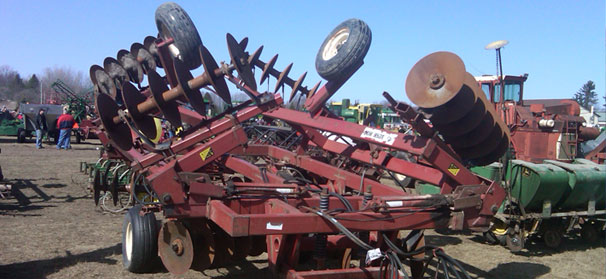

Oct 24, 2011Used equipment could be carrying pests, diseases
For many vegetable growers, winter is a time to plan for the coming growing season, which often means contemplating the purchase of additional equipment.
A good share of the vegetable industry relies on specialized equipment to plant, care for and harvest a number of crops. When in need of additional equipment, many growers find themselves traveling much longer distances than in previous generations to acquire vegetable machinery. The Internet has made it very easy for large and small growers to search out a specific piece of equipment located anywhere in the United States, and even in other parts of the world.
When inspecting a used piece of machinery, buyers typically look to see that the machine is of the proper specifications – that it is the right capacity and size to do the job intended. Buyers examine wear points to determine the useable life left in the machine before major repairs are needed, and assess the weathering and rust that affects the longevity of the machine. Some might even, out of habit, kick a tire. During this evaluation process, they should also assess the likelihood that the machine may contain soil or plant debris that could introduce a new plant disease or other pest to their farm.
A few examples to consider are:
Phytophthora fruit and crown rot is present in many parts of Michigan and can be a devastating disease to cucurbits, as well as other vegetable crops. Many areas of Michigan have not reported the disease, and several farms do appear to be disease-free. It is a fungal disease that can survive in soil or plant debris for several years, until a host crop is grown.
While not a vegetable disease, soybean sudden death syndrome (SDS) is an excellent example of a fungal disease that survives in the soil and has spread in recent years. In 2009, six counties had confirmed cases of SDS, and in 2011 at least 13 counties documented the disease. One of the likely ways the disease has spread is on soil-contaminated machinery.
Potato cyst nematode is present in the United States and Canada and is fairly widespread in parts of Europe. Where present, this pest can reduce potato yields by 40 percent or more. A quarantine has been in place in the United States since the 1940s to limit the spread of this pest. Due to this quarantine and its enforcement, the likelihood of buying equipment contaminated with potato cyst nematode is fairly low; however, it is another example of a pest whose history is linked to the movement of contaminated machinery.
Palmer amaranth, a weed in the same family as red root pigweed, has appeared in a few fields in southern Michigan. While it is thought to have found its way to Michigan in a load of livestock feed ingredients, its seed is very small and could likely hitch a ride any number of ways, including on a farm tool. This weed is very prolific, can easily grow to heights of 8 feet and is resistant to Glyphosate (Roundup).
There are many more pests and diseases that could be listed, and there are likely a few that we do not yet know are threats. My recommendation is to make reasonable efforts to clean tools before they come to your farm.
Tillage tools have the potential to carry large amounts of soil. Many tillage tools found on equipment consignment sales this past season had anywhere from a couple of handfuls of soil to a couple of buckets full. Often, a large amount of soil can be knocked off without using more than a broom. Pressure washing will greatly reduce the chance of a pest hitching a ride.
Planting equipment can be a little more challenging. Like tillage tools, planters come in contact with the soil and have similar risks of carrying soil along with them. However, planters tend to be more complicated and sophisticated tools than tillage equipment. Soil can build up behind disk openers and around seed tubes, where it is not easily visible or accessible. It may be worthwhile, when the tool arrives, to remove and reinstall components that come in contact with the soil. On many planters, disk openers can be removed somewhat easily to check for deposits of soil, as well as to check for worn parts such as seed tubes, bearings and seals.
Vegetable growers often take rotational crops for granted. Grain-harvesting equipment, however, does deserve a bit of attention. Grain combines can carry substantial amounts of weed seeds. Consult the operator’s manual for machine clean-out procedures. Clean out the stone trap if the machine is equipped with one. Compressed air is typically used instead of power washing to clean combines, due to the dry nature of the material and the desire to keep the machine dry.
There are many other ways a new pest can find its way onto your farm, but a few hours of cleaning machinery before it’s used may prevent several hours of managing a new pest problem in the seasons to come.
By Fred Springborn, Michigan State University














